Imagine you want to build your dream house. You know what it will look like, but you have no construction knowledge. What if architectural plans and blueprints didn’t exist? How in the world would you explain your idea to a builder?
That’s exactly how it feels to work without a creative brief. You might have an idea of what you want, but you have no idea how to achieve it.
A creative brief bridges this gap. It breaks down the specific elements of your project and provides a clear pathway from concept to finished product.
In this article, we’ll show you the essential elements of an effective creative brief. Plus, we’ll look at several creative brief examples (including content briefs) to get your creative juices flowing.
What is a creative brief?
A creative brief is an overview of a creative project such as a marketing or advertising campaign. As we’ll see, it covers everything from project goals to deliverables to distribution plans.
A creative brief:
- Gives all relevant teams and stakeholders visibility into project details
- Serves as an accessible reference point or central hub for high-level project info
- Keeps team members (including external and internal teams) on the same page as creative work progresses
This prevents various issues:
- Misunderstandings about project scope and goals
- Contributors acting independently, which can negatively impact the cohesiveness of the end product
- Confusion about who key stakeholders are or who is responsible for approvals
Sound familiar? Content briefs and creative briefs serve similar purposes, so they’re often confused. But the two are a bit different.
Creative brief vs. content brief: What’s the difference?
Content briefs and creative briefs differ primarily in scope.
Creative briefs contain instructions for producing a wide range of creative deliverables. They work for any creative project—not just written content. These briefs generally include different elements from the content brief. Details like company background information, campaign goals, key messaging, and brand statement(s).
Creative briefs contain instructions for producing a wide range of creative deliverables—not just written content. Among other things, they generally include company background information, campaign goals, key messaging, and brand statement(s).
Creative briefs are commonly used by creative teams—for example, a team at an advertising agency. Creative briefs include the following elements:
- Web or graphic design briefs
- Content briefs
- Strategy briefs
- Copywriting briefs
- Marketing campaign briefs
- Social media campaign briefs
Notice that a content brief is one kind of creative brief.
Content briefs help writers create content that matches marketing goals. Typically, they’re geared toward helping writers produce SEO-friendly content while covering the full scope of the topic.
7 creative brief examples (content briefs included)
With their differences in mind, let’s look at seven creative brief examples—content briefs included—for some inspiration.
1. Bynder’s Content Workflow




 Bynder’s Content Workflow Content Project Brief Template
Bynder’s Content Workflow Content Project Brief Template
Are you planning a large content project? If so, this content project brief template will be an invaluable resource for your content marketing team. The template covers everything from the project summary to key performance indicators (KPIs) and budget. All you have to do is fill it in with your project details and make it available to your team.
While this template is specific to content, it falls into the broader category of creative briefs. This is because it’s for a larger project, not a single piece or a small part of a marketing plan. So, this is creative brief example is high on the list.
2. Omniscient Digital



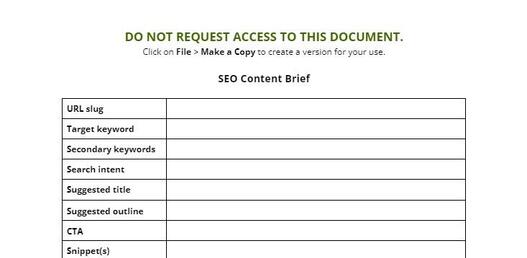
 A snippet of Omniscient Digital’s content brief template
A snippet of Omniscient Digital’s content brief template
Content agency Omniscient Digital uses a comprehensive content brief. It includes keywords, SEO metadata, an audience description, search intent, competitor content, and more.
3. PayPal




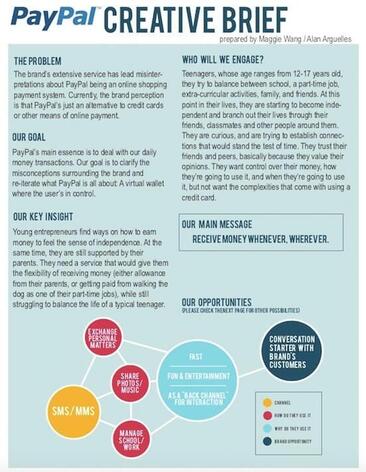 PayPal creative brief example
PayPal creative brief example
This sample creative brief for PayPal shows the difference between content and creative briefs. As you’ll see, this marketing campaign brief is not for writers. Instead, it focuses on the brand’s marketing strategy, including elements such as key insights and PayPal’s brand statement.
4. Reebok




 Reebok creative brief example
Reebok creative brief example
This creative brief for Reebok is a good example from a customer focus standpoint. While it’s shorter than many briefs, it does go into detail about the target audience. It covers who they are and their life circumstances. Not to mention the top challenge they face and how the brand addresses that challenge. These are details copywriters, designers, and others involved in print ad creation find useful.
5. Content Harmony


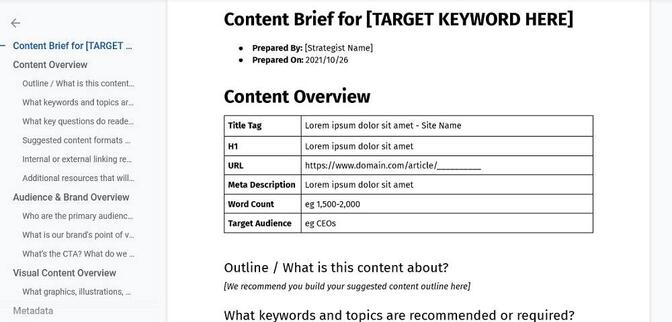


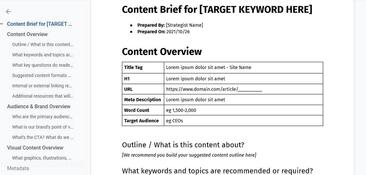 Content Harmony content brief example
Content Harmony content brief example
Content Harmony uses a mix of tabular and text formats for its content briefs. It also includes details like the strategist’s name, content management system (CMS) settings, suggested content outlines, and internal and external links.
6. Coca-Cola


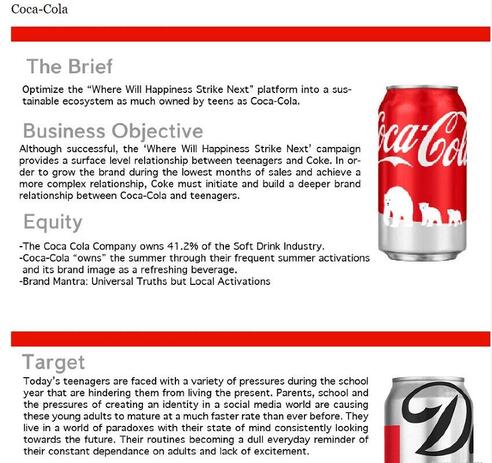
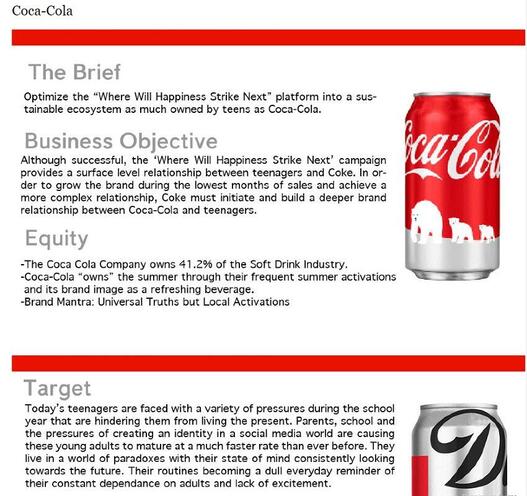
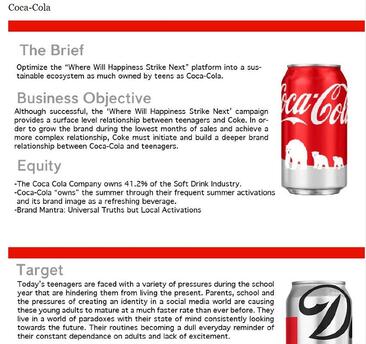 Snippet of a creative brief for Coca-Cola
Snippet of a creative brief for Coca-Cola
One of the more in-depth creative brief examples on our list, this brief for Coca-Cola teaches several lessons. It doesn't just give a basic description of the target audience. It also covers their current perception of the brand and how the campaign proposed should change it. Plus, it gives campaign ideas for inspiration, showing how the info in the brief could be applied.
7. Zapier

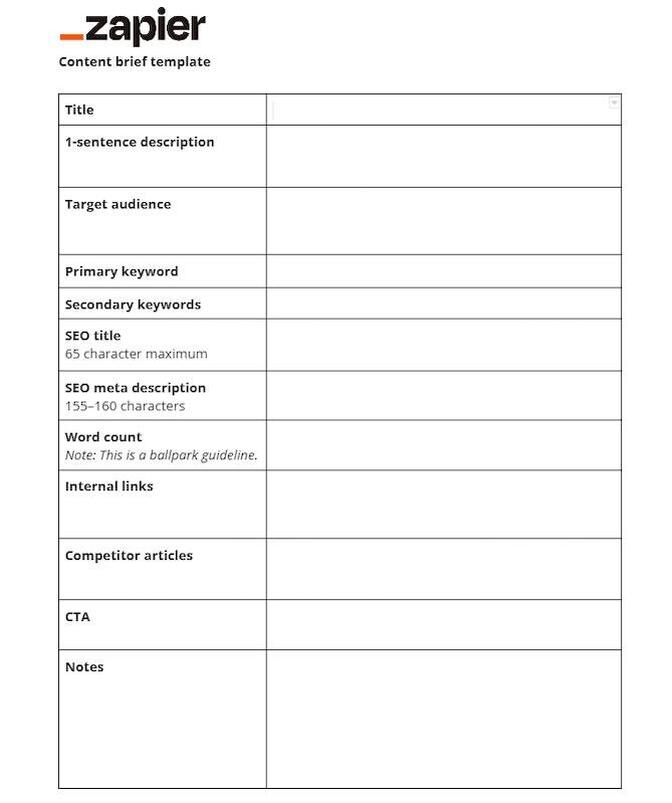


 Zapier content brief template example
Zapier content brief template example
The Zapier blog has a comprehensive but straightforward content brief template. It includes a one-sentence description, ballpark word count, and call to action, among other details.
How to write a creative brief: 12 elements to include
Of course, elements of creative briefs vary depending on the project type. For example, a graphic design brief would have a heavier focus on visual elements than one for a copywriting project. But here are 12 elements that are commonly seen across many types of creative briefs.
1. Project name
This may seem like a trivial thing. But everyone involved in a project needs a singular, memorable way of referencing the project name. Everyone having their own nickname for an initiative results in unnecessary friction and confusion.
2. Project summary
Rather than diving right into the specifics of a project, a great creative brief will lead with a summary of the foundation of your project:
- Your or your client’s company or organization
- What the project is and why it’s important
- Main project goals
To be clear, team members and stakeholders shouldn’t treat this as a TL;DR. (It’s not comprehensive enough to be a standalone info source.) Yet, it is helpful to have a concise overview to refer to when necessary.
3. Buyer persona(s)
Any good creative brief will answer the question, “Who are we trying to reach with this initiative?” Speaking on the importance of including buyer personas, Christiaan Huynen of Designbro says:
This information allows one to easily visualize and verbalize what the customer needs and not what the company is doing. With this simple shift of perspective, you’re able to show that you understand your audience and be better at building trust.Christiaan Huynen
Nothing is better than making the audience feel that they’re heard and understood to make them listen and trust you.
Founder and CEO at Designbro
But typical buyer personas have some flaws. For one thing, too few are informed by actual input from customers.
You’ll have an incredible advantage if you build personas on validated customer insights. Don’t guess. Learn their biggest pain points, goals, motivations, and hesitations. Then, observe the language they use to communicate those things. This is the way to make your audience feel heard and understood, as Christiaan mentioned.
Additionally, realize that strong buyer personas don’t mean your creative work will automatically resonate. Deniz Kuran, Head of Marketing at Idiomatic, explains:
I think the most important thing that appears in a creative brief is the answer to the question, ‘Why should the audience believe us?’ It goes much further than, ‘Who’s the audience?’ We have to answer why our content will appeal to them, why they want or need it!Deniz Kuran
Head of Marketing at Idiomatic
4. Drivers and objectives
Work quality hinges on how well internal teams and external contributors understand the drivers behind a project. Give context on the project’s purpose and the problem you’re trying to help your audience solve.
This leads us to the topic of objectives. Rather than non-descript outcomes like “we want more leads,” get specific about what targets you want to hit. What metrics will be important? How will you measure them? If you value a metric like brand awareness that’s not as measurable as others, how will you judge the success of the project?
5. High-level competitor overview
You don’t need to include all of your competitor research here. Give a brief overview of direct competitors’ strengths and weaknesses. Also, mention any significant threats they pose to the success of your project.
Defining how you’ll meet the needs of your audience is important, of course. But including competitor info also gives your team a clearer picture of how this project stacks up to the competition:
- The project is an answer to competitors’ efforts to outcompete you
- The team appraoches their part of the project to help your or your client’s organization gain the upper hand
6. Messaging guidelines
All creative projects convey a message. So, whether for design, copywriting or anything else, creative briefs should include messaging guidelines of some sort.
Identify the theme of your project, your unique value proposition, or the main takeaway for your intended audience. Beyond that, consider outlining (at a high-level) what messages, themes or ideas shouldn’t be part of your messaging.
7. Tone of voice guidelines
Closely linked with messaging, specify the appropriate tone of voice for the project. Why does this matter? Tone—how you say what you say—should vary depending on:
- Your audience as a whole
- The subset of an audience you’re talking to
- Subject matter
- Content type
- Distribution channel
Voice of customer research, in particular, can help you identify the best way to get your message across to your audience.
8. Relevant assets and deliverables
What will you produce during your project? List out deliverables large and small. Also, mention any existing assets that will inspire or help with deliverable creation.
9. Budget
How much money you have to spend determines the approach your team will need to take to get the outcome you want. Clarify the total budget and, if necessary, budgets for individual teams or elements of a project.
10. Project timeline
According to Will Yang of Instrumentl, timing is a commonly forgotten element in creative briefs. But it’s one that “can be hugely important in ensuring the success of a project.” Will continues:
Particularly for complex projects with multiple stakeholders, it’s essential to set realistic deadlines at the outset and to build in adequate time for each stage of the process.Will Yang
By doing so, you can avoid the common pitfall of rushed or incomplete work. In addition, careful timing can help to ensure that the project stays on budget.
Head of Growth at Instumentl
A good creative brief should outline the project workflow and how much time will be allotted for each stage.
11. Stakeholders
Outlining key people involved in your project saves time and prevents confusion. For example:
- Key people direct contributors to the appropriate points of contact for questions or concerns
- Stakeholders allow contributors to give feedback in a timely manner
- They make sure deliverables get the necessary approvals before moving to the next stage
But do more than make note of who stakeholders are. Stacey Danheiser of Shake Marketing Group also recommends getting their approval on the brief:
Like it or not, many companies do 'creative by committee.' That can be a problem when one marketer is filling out the creative brief (without any input from the stakeholders that will later be involved in reviewing the content!).Stacey Danheiser
Ask, "Who else will be involved in reviewing and approving this content or creative?" Then, make sure those people sign off on the brief to help get alignment upfront, rather than during the creative review process.
Founder at Shake Marketing Group
12. Distribution strategy
Detail what channels you’ll use to distribute final deliverables or end products to your target audience. These channels could, of course, be digital (e.g. social media) or physical (e.g. billboards). But, whatever they are, mention them in the brief so that team members know what to optimize their work for.
Use creative briefs to streamline your content workflows
The creative brief is a map covering the major touchstones, but not necessarily all the attractions. It's critical for keeping all team members and stakeholders on the same page. But it’s not the be-all-end-all.
Don’t forget to leave room for creativity, even as you fit in the major elements (e.g. target audience, messaging and tone guidelines, etc.).
Looking to optimize your content creation process? If you’re tired of juggling multiple platforms for brief creation, content writing, and content reviews, it’s time to try out Bynder’s Content Workflow.











